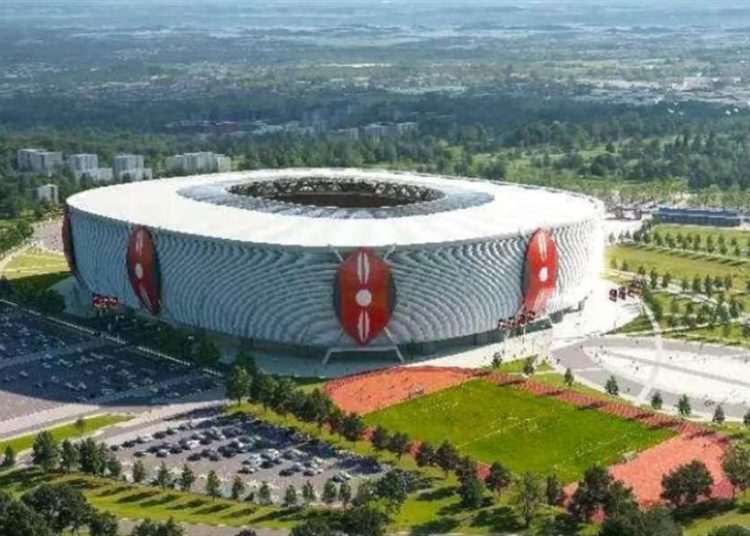Talanta Sports Stadium, also known as Talanta Sports City, is a significant development in Nairobi, Kenya, aimed at enhancing the country's sports infrastructure. The project was commissioned in March 2024, with construction commencing shortly thereafter. Located at the Jamhuri Grounds along Ngong Road, approximately 10 kilometres west of Nairobi's central business district, the stadium is set to become a premier venue for football and rugby events in Kenya.
The facility is designed to accommodate 60,000 spectators, making it one of the largest stadiums in the region after completion. The Ksh 45.3 billion ( $350 million) project is a collaborative effort between the Government of Kenya and the private sector via a public-private partnership (PPP) model, with China Road and Bridge Corporation (CRBC) as the main contractor.
A PPP model is where private partners, in this case CRBC, meet the project’s cost and once completed, charge and collect fees to recoup investments over a given period, often more than 20 years. This saves the government from meeting the development budget or borrowing, which can be costlier.
In the Talanta Sports Stadium project, local and international designers collaborated on the architectural plans, which included the University of Nairobi's Enterprises and Services Limited and Professor Erastus Abonyo, the lead consultant. This collaboration delivered a blend of global standards and local cultural aesthetics.
The design draws inspiration from Kenyan cultural symbols, aiming to reflect the nation's rich heritage. It incorporates elements reminiscent of traditional Maasai shields and spears, symbolizing strength and unity. The stadium will feature state-of-the-art facilities, including VIP lounges, modern locker rooms, and advanced media centers, ensuring it meets international standards for hosting major sporting events especially as stipulated by the Confederation of African Football (CAF).
One of the key highlights of the design is the absence of an athletics track, focusing solely on football and rugby to provide an intimate and engaging experience for spectators.
CRBC, renowned for expertise in large-scale infrastructures, is constructing the Stadium, having delivered similar capital-intensive projects in the country, including the Nairobi Expressway and Standard Gauge Railway (SGR). For the stadium project, advanced construction technologies have been employed to ensure efficiency and adherence to international standards.
The construction is expected to lapse by December 2025, a speedy two-year span. This timeline is strategically planned to ensure the stadium is ready to host events for the 2027 Africa Cup of Nations (AFCON) which Kenya will co-host with Tanzania and Uganda. Without standard sports facilities, the East Africa region, where Kenya is the economic powerhouse, risks losing AFCON hosting rights. This will be a blow to other related sectors of the economy like tourism, hospitality and transport.
Amid fiscal constraints, Kenya is bending more towards the PPP model to complete big-ticket infrastructures while ensuring proper utilisation of resources and maintaining accountability. Completion of the Talanta Sports City stadium will mark President William Ruto’s legacy project in the first term.
The government has a crucial role in offering regulatory oversight as CRBC brings technical knowledge. Although the project is currently under construction, significant progress has been made in foundational and structural works with the sports Cabinet Secretary (CS) doing several inspections ahead of the 2027 AFCON.
The installation of utility systems and initial work on the stadium's seats and sports facilities are also ongoing. The project's phased development ensures that each element of the stadium meets international standards. For the local community along Ngong Road and the nation as a whole, the Talanta Sports City Stadium is set to deliver transformative benefits, especially in talent nurturing.
As a state-of-the-art facility, it will elevate Kenya’s position in international sports by providing a venue that meets FIFA and World Rugby standards. This will enable the country to host regional and global tournaments, boosting its profile on the world sports stage.
From an economic perspective, the stadium has created numerous jobs across various sectors, including construction and after-construction jobs, events management, and stadium operations. Its modern training facilities will nurture local talent, providing a platform for young athletes to hone their skills and compete at higher levels.
Beyond sports, the stadium will serve as a multipurpose venue, hosting cultural events, concerts, and exhibitions that foster community engagement and cohesion. Moreover, the architectural marvel of the stadium celebrates the Kenyan spirit with symbolisms of the Kenyan flag embedded in the façade design.
However, the promising project has also raised several public concerns. The biggest of these is the issue of financial transparency and economic viability given that previous projects such as SGR and Nairobi Expressway, both constructed by CRBC, have struggled to generate revenue as initially projected. Kenyans especially the popular Gen Z critics and stakeholders have called for greater accountability and detailed reporting on expenditures to ensure funds are used responsibly.
Environmental sustainability is another critical concern. The large-scale development has sparked discussions about its impact on local ecosystems and green spaces around the Jamhuri Grounds, known for the green spaces that surround it. One of the merits is that the project will incorporate eco-friendly practices, such as renewable energy systems and rainwater harvesting. To minimize its ecological footprint, as shown in the design proposals, the incorporation of cross ventilation systems along the façade walls goes a long way in eliminating the need for Air Conditioning.
Traffic management around the stadium is also a pressing issue considering that Ngong Road is the only access to the stadium. Increased activities are likely to strain the existing road infrastructure, prompting the need for comprehensive traffic plans, including improved road networks along Ngong Road. Inclusivity is another necessary consideration with the public emphasizing the importance of ensuring that the stadium is fully accessible to persons with disabilities.
Construction Insights is a section of DezynBild Consult, that brings you insights on architecture, real estate & construction and matters of public projects.
This particular piece was put together by Lameck Owesi and Raphael Muindi, through a period of detailed research. Edited by Herald Aloo.
DezynBild Consult provides professional services in Architectural Design & Construction Project Management. WhatsApp Us: +254 715 429 997 | Email us: dezynbildconsult@gmail.com or info@dezynbild.com
Image Credits: The Standard


It will also offer space for talented CBC clients coming up with full blast
This article is very insightful, well-researched and thoughtfully written. It has enhanced my understanding on the topic. Well done
Great piece with detailed information and insights that keeps us up to date with current development. Looking forward to more of this.
Wow,wow,wow!this is a masterpiece, quite insightful.A great idea especially on talent development and nurturing.CBC well represented here.Kudos team
Very insightful piece
It's an innovative design. The planned incorporation of cross-ventilation systems along the facade walls is a smart and sustainable design feature, particularly in Nairobi's climate. This reduces reliance on air conditioning and promotes energy efficiency. Bravo!